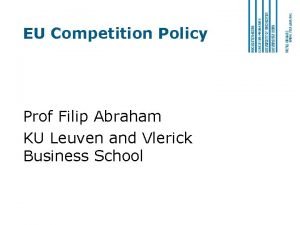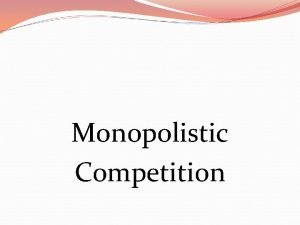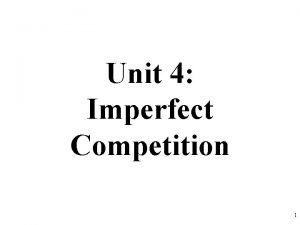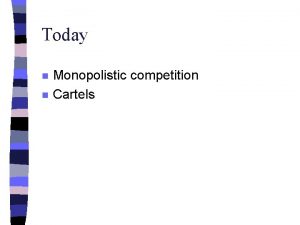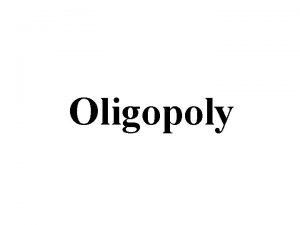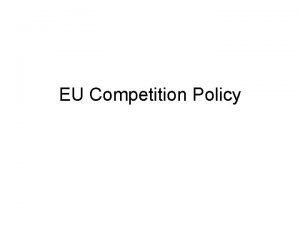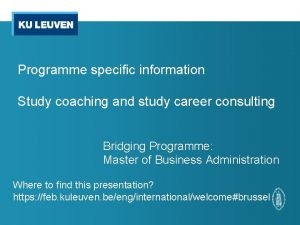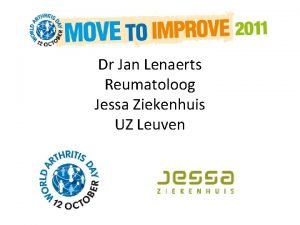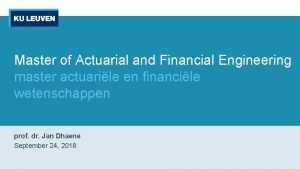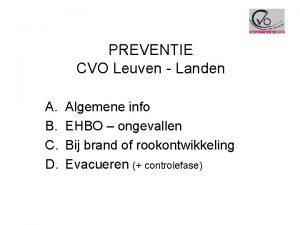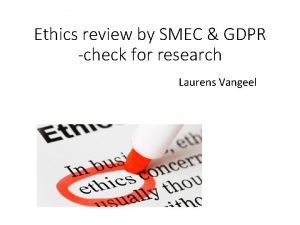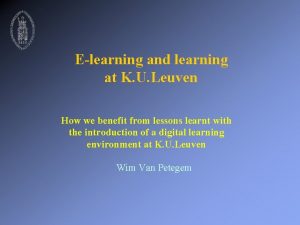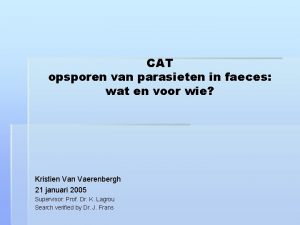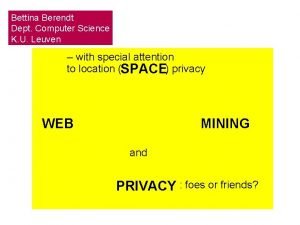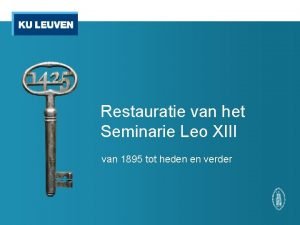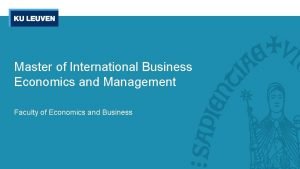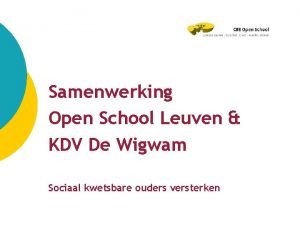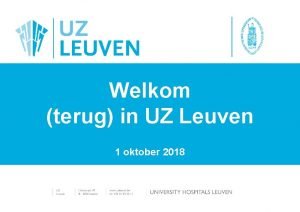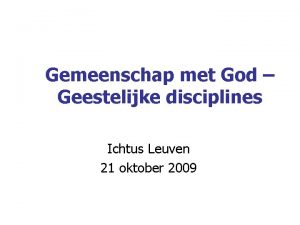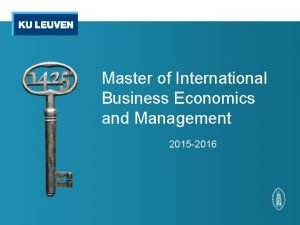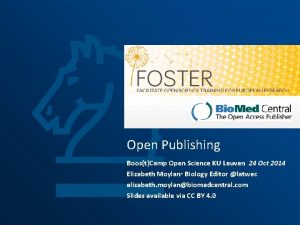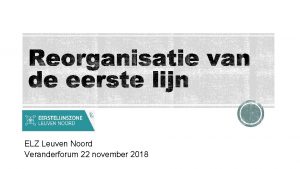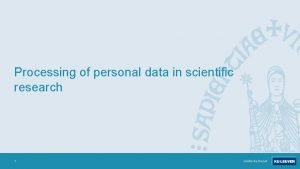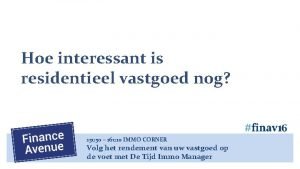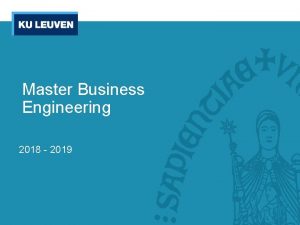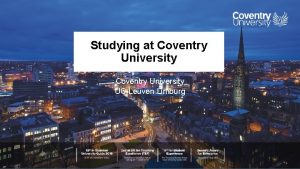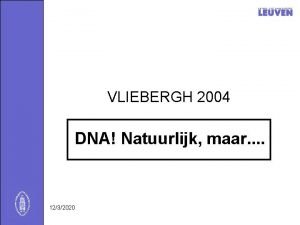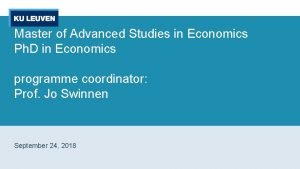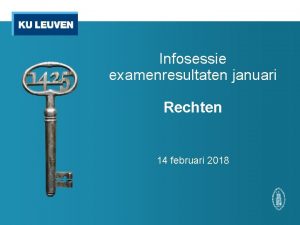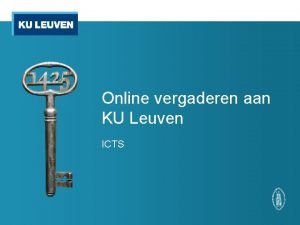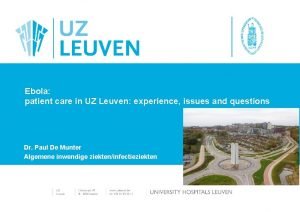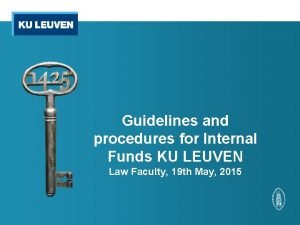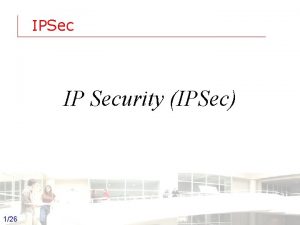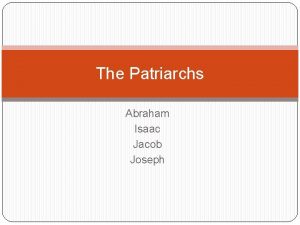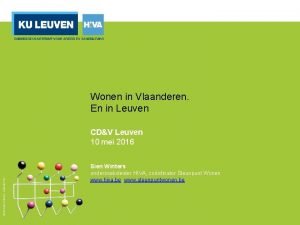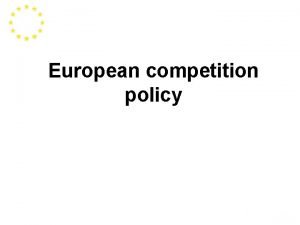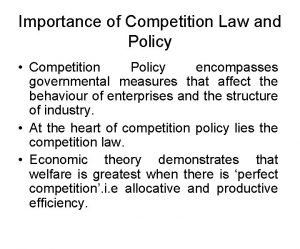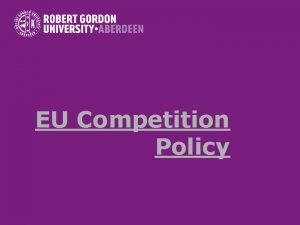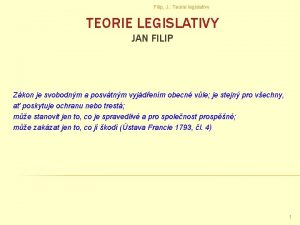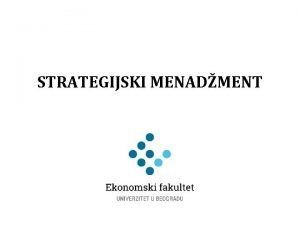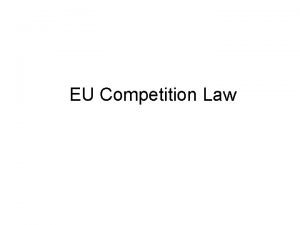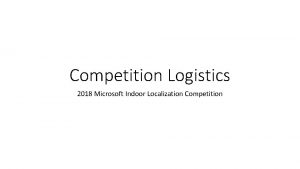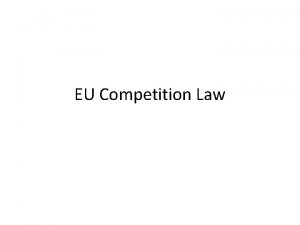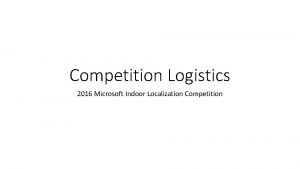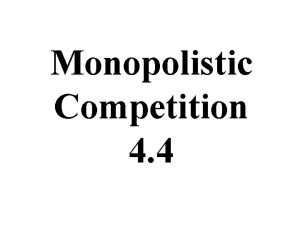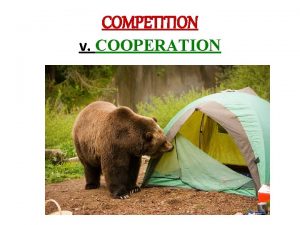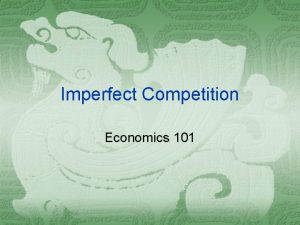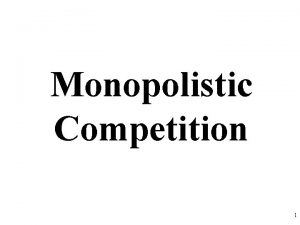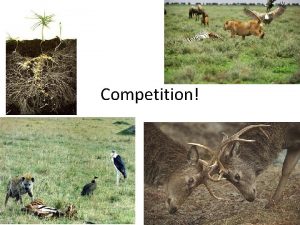EU Competition Policy Prof Filip Abraham KU Leuven

EU Competition Policy Prof Filip Abraham KU Leuven and Vlerick Business School

What is Competition Policy? Competition policy has the objective of managing competition in product markets through: § merger control: preventing anti-competitive mergers and acquisitions (M&A’s) § antitrust policy § preventing cartels and other anti-competitive agreements § preventing abuses of dominant position § state aid control (in the EU) § limiting distortions to intra-EU competition and trade resulting from national subsidies § But allowing subsidies when it is in common (EU) interest Competition is based on the territorial principle, not on the nationality of the companies involved 2

Who is in Charge? § no multilateral competition authority § US § long tradition § focus on dominant positions and M&A’s § federal government and courts in charge § Europe § national governments and EU Commission § subsidiarity principle: EU Commission deals with larger and cross-border cases § Asia § recent interest in control of dominant positions and M&A’s 3 § national governments in charge

Why is Competition Policy Important for Business? § competition authorities can hurt companies by: § blocking M&A’s, imposing fines and ordering the repayment of subsidies § negatively affecting the valuation of companies by financial markets § involving the company in a long and expensive battle with the competition authorities § causing severe reputational damage § companies should be prepared § top managers should be aware of the basic rules of the game § laywers of the companies should have an expertise in competition policy 4 § or/and the company should rely on specialized law firms

European Fines in Recent Cases Company Year Fine in millions of € Sector Intel Microsoft Saint-Gobain Microsoft Thyssen-Krupp Hoffman-La Roche Siemens Pilkington Sasol Limited Microsoft 2009 1 006 2008 899 software 2008 896 car glass 2013 561 software 2004 497 software 2007 479, 8 elevators 2001 462, 2 vitamins 2007 396, 5 electrical parts 2008 370 car glass 2008 318, 2 chemicals 2006 280, 5 software computer chips 5

Anti-Trust: The EU against Microsoft § complaint by Sun Microsystems in December 1998 § the ruling of the Commission on March 24, 2004 § technical information for servers § bundling of Media-Player § fine of 497 mio € § court appeal for delay of sanctions rejected in 2004 § December 22, 2005: new fine of 280, 5 mio for not complying with the ruling § September 2007: the European Court of First Instance backs the 2004 decision of the Commission § 2008: fine of 899 mio € for not providing information to competitors. Microsoft appeals § 2009: Microsoft accepts compromise: Windows allows choice between different internet browsers § 2012: fine of 899 mio € is reduced in appeal to 860 mio € § 2013: new fine of 561 mio € for breach of the 2009 compromise in Microsoft Windows 7 Service Pack 1. §several similar cases in recent cases: e. g. Google, IBM, … 6

Merger Policy: Dealing with Cross. Border Mergers and Acquisitions

The “friendly” Take-over of Air Lingus by Ryanair 8

Three Attempts of Take-Over § Ryanair is minority stakeholder of Aer Lingus with 29. 8 % of the shares ahead of the Irish government with 25. 1% § Case 1: 30/10/2006 -27/06/2007: prohibition § Case 2: 8/01/2009 -23/01/2009: case withdrawn § Case 3: 24/07/2012 -27/02/2013: prohibition

The Two Players Ryanair Europe‘s largest low frills carrier 400 routes in 24 countries 51 bases, main: Dublin, Brussels South, Milan Bergamo and Stansted 305 aircraft, 62 routes out of Dublin “point-to-point”/”no-frills” Aer Lingus Ireland‘s old ”flag carrier“ 66 routes ex-Ireland 3 bases (Ireland), main: Dublin “point-to-point”/”mid frills 10

Methods of Investigation § extensive use of standard investigative methods (questionnaires, interviews, site visit in Dublin, etc). § views from a large number of market participants inside and outside Ireland including competitors, customers, travel agents, consumer associations, public authorities and airport carriers § customer survey among passengers at Dublin airport § econometric analysis as complementary evidence § regression analysis to identify the level of competitive constraints between the merging parties and by competitors § price correlation as an input to market definition 11

The Relevant Market § main criterium: substitution in demand supply § relevant product market: direct scheduled air transport passenger services § relevant geographic market § “city-to-city" approach: routes between a given point (or region) of origin an a given point (or region) of destination § airports in a city/region are competing § routes out of Ireland (Dublin) and London (Stansted) § no significant impact of charter airlines § no separate market for "time-sensitive” passengers § overlapping routes (= 46 markets in 2012 up from 35 in 2007) 12

Actual Competition: Market Shares of Passengers from and to Dublin combined market shares of Ryanair and Aer Lingus increased from 80% in 2007 to 87% in 2012 13

Actual Competition: Overlapping routes 35 overlapping routes in 2007 46 overlapping routes in 2012 market positions in the overlapping routes of Aer Lingus and Rynair strenghtened in the period 2007 -2012

Actual Competition: Market Shares on Overlapping Routes in 2012 Horizontal merger guidelines, court rulings and case law state that very large market shares of 50% or more may in themselves be evidence of the existence of a dominant market position 46 overlapping routes 28 monopoly routes combined market share 100% 11 routes only competition from charter airlines 7 routes - very high market shares - competition from other scheduled carriers who often connect passengers to their network hubs (e. g. British Airways, Lufthansa and Air France) 15

Actual Competition: Do the companies compete on overlapping routes? § Econometric analysis establishes that: § Ryanair and Aer Lingus are each others’ closest competitors on many routes § Ryanair's presence is associated with Aer Lingus charging around 7 -8% lower prices when considering city-pairs and around 5% lower prices when considering airport-pairs. § Both airlines monitor each other prices and react accordingly 16

Ryanair’s promotion materials 17

Aer Lingus’ Promotion Materials 18

Potential Competition § Irish airports are hard to penetrate for new competitors § The Irish markt is a small peripheral market with limited growth § Aer Lingus and Ryanair have a strong base § newcomers would face substantial sunk costs for marketing, promotion, brand recognition § Easy. Jet has tried and failed § Several companies (e. g. BA) have left Dublin 19

Vertical Integration § The Dublin Airport is congested § There are few slots available § There is runway congestion § There is terminal congestion 20

The Efficiency Defence Ryanair claims that: consumer benefits from cost savings from economies of scale and better management of Aer Lingus Cost savings to be realised on Aer Lingus according to Ryanair Million € per annum staff costs 75 -85 aircraft costs 35 -45 airport charges 2. 5 -3. 5 improved aircraft utilization 10. 5 - 1. 5 fuel and oil costs 5 -10 maintenance costs 50 -70 distribution costs 9. 5 -10. 5 advertising 6 -8 total 200 -250 the efficiency defence is rejected because: § Aer Lingus argues it is cost efficient and disputes the estimates of Ryanair § the Ryanair model is specific and cannot automatically be imposed on another airline § the cost savings and the benefits to the consumer are not verifiable ir consumer benefits from cost savings from economies of scale and better management of Aer Lingus § Aer Lingus could achieve many of the cost savings without the merger 21

No take-off…. . § Ryanair offered commitments/remedies. Final remedies consisted of: § divestiture of Aer Lingus’ operations on 43 overlapping routes to Flybe § giving up a number of take-off and landing slots so that IAG/British Airways could compete on 3 routes from London to Dublin, Shannon and Cork § Flybe and IAG/British Airways committed to operate the routes for three years § The Commission rejected the final commitments/remedies: § insufficient counterweight to the position of the merged Ryanair-Aer Lingus entity § doubt on whether the proposed remedies could be put in place in a timely matter § uncertainty about the commitment to continue operating the routes after the three years § National case by UK competition authority: Ryanair is asked to lower its 24% equity stake in Aer Lingus to reduce anti-competitive interference in Aer Lingus’ business strategy 22

State Aid Policy in the EU Dealing with National Subsidies that Distort Competition

24

25

What is a Subsidy? government involvement subsidy instrument Evaluation of Subsidies 26

What is a Subsidy? The Banking Crisis 27

What is a Subsidy? Focus on Several Instruments in the Banking Crisis § guarantees of bank liabilities § recapitalisations § impaired asset relief § support for bank restructuring 28

What is a Subsidy? Are Tax Advantages Considered as State Aid? § from an economic point of view, tax advantages can contain a subsidy element § EU has been cautious in legislating taxes § first pillar issue: EU can legislate § but many EU member states consider the right to tax as a part of national sovereignty § unanimity requirement for EU tax laws § recent global effort to close tax loopholes § EU is increasingly using state aid policy to force companies in paying higher taxes

government involvment What is a Subsidy? How big is the Subsidy? subsidy instrument benefit to the firm cost to the government Evaluation of Subsidies 30

Size of the Subsidy of National Governments to Banking in the Post-Lehman Period 31

government involvment What is a Subsidy? How big is the Subsidy? subsidy instrument benefit to the firm Evaluation of Subsidies cost to the government What Type of Subsidy? Selectivity regional horizontal sector- or firm-specific 32

Selectivity: How to “Horizontalize” Banking Subsidies? 33

Selectivity: The Double Irish § overall corporate tax rate in Ireland is 12. 5% § double Irish tax scheme used by e. g. Apple § Apple attributes global profits to its Irish subsidiary § the Irish-based subsidiary makes royalty payments to a second Irish subsidiary managed from a tax haven with zero profit taxation § the Irish-based subsidiary from Apple makes royalty payments to the second subsidiary and claims those payments as tax deductions in Ireland § is this a selective subsidy?

government involvment What is a Subsidy? How big is the Subsidy? subsidy instrument benefit to the firm cost to the government What Type of Subsidy? Selectivity What is the Objective of the Subsidy? Evaluation of Subsidies regional horizontal sector- or firm-specific Does subsidy distort competition? 35

Does Subsidy Distort Competition? The Banking Case § important cross-border dimension: banks compete across national jurisdictions § member states do not internalize effects beyond their national jurisdictions § danger of subsidy wars and conflicts between member states § different ability and willingness to support banks § incentives of banks: avoid distortions between aided and non-aided banks, avoid moral hazard 36

government involvment What is a Subsidy? How big is the Subsidy? subsidy instrument benefit to the firm cost to the government What Type of Subsidy? Selectivity What is the Objective of the Subsidy? Evaluation of Subsidies regional horizontal sector- or firm-specific Does subsidy distort competition? approval prohibition conditional approval 37

Conditional Approval in Banking: Guidelines on Rescue Aid 38

Conditional Approval in Banking: Guidelines on Restructuring Aid 39

Final Decision: Conditional Approval 40

41
- Slides: 41
